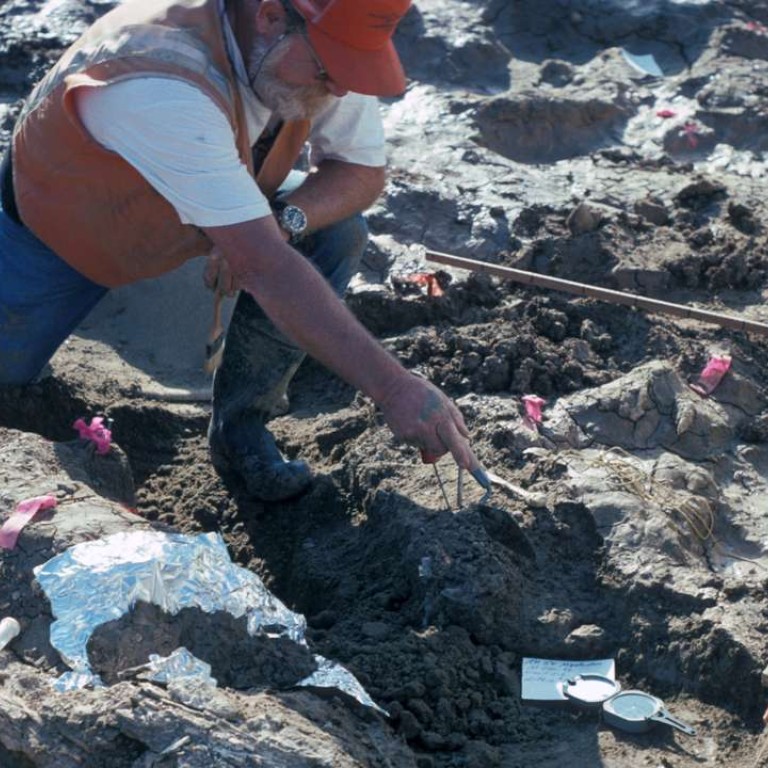
130,000-year-old bones could shatter the story of when humans first appeared in the Americas
Shattered mastodon bones from a Southern California site bear the scars of human activity from 130,700 years ago, a team of scientists says — pushing back the generally accepted date that humans are thought to have settled North America by a whopping 115,000 or so years.
If verified and corroborated by other scientists, the discovery described in the journal Nature could radically rewrite the timeline of when humans first arrived in the Americas.
“This is the first time there’s been a demonstrated archaeological site with all the bells and whistles,” said Curtis Runnels, an archaeologist at Boston University who was not involved with the study, referring to the combination of several lines of evidence at the site. “This makes it absolutely first-water importance. This is up there with one of the discoveries of the century, I would say.”
Without the benefit of actual human remains, however, the dramatic departure from the accepted timeline may not persuade all scientists in the field.

The fragmented mastodon remains were first discovered in late 1992 by study co-author Richard Cerutti of the San Diego Natural History Museum, during routine palaeontological monitoring work at a California Department of Transportation freeway expansion project in southern San Diego. Out of the ancient stream deposits came the remains of a camel, horse and other mammals — including the bones, tusks and teeth of a mastodon, a distant and long-gone relative of elephants.
The mastodon fossils looked very different from the other bones nearby. The animal’s limb bones, molars and tusks had been smashed into many pieces. That struck the researchers as odd, because leg bones are strong and thick and should have been preserved over the eons — especially since more fragile ribs and vertebrae had survived in much better shape.

The ends of some bones had been torn off — a sign that humans may have been trying to reach the bone marrow. The mastodon bones also bore the spiral fracture patterns that are typical of breaks that happen when the bone is still fresh, rather than the straight ones that tend to mark older bone broken much longer after death. (The wolf and horse bones in nearby sediment layers did not exhibit the same patterns.)
That strange, selective destruction is a sign that humans were there, targeting the thick bones and tusks that could be shaped into new tools, the study authors said.
On top of that, the bones were not arranged in the way that usually happens when an animal dies from natural causes. Instead, the bones had been grouped into two clusters — and near each bunch of bones lay two or three large stone cobbles.
If humans broke those mastodon bones, they probably did it using the large cobbles, the scientists said.


“We’re confident that we have a very good idea of when this animal died and when bones were incorporated in the surrounding sediment,” Paces said.
The commonly held theory of humans’ arrival in North America is that they came 14,500 years or so ago via a land bridge that was only intermittently open. Recently, some scientists have begun to argue that humans may have entered well before that, around 30,000 to 40,000 years ago — though who they may have been and whether they could have established a lasting population remains up for debate. This new find, however, pushes back the record of human species far beyond scientists’ expectations.
If people were in California 130,000 years ago, it’s possible that they made it over the ice bridge just before the last interglacial period. It’s also possible that they took to the sea in boats, crossing the brief stretch of open water between Asia and North America and then making their way down the Pacific coastline.
But were these humans the ancestors of anatomically modern humans — or were they perhaps another species, such as Homo erectus or Neanderthals? It’s impossible to say for now, given that there are no human remains at the site. If they were of another species, it could reshape the way we think about the abilities and history of our long-gone close cousins, said study co-author Richard Fullagar, an archaeologist at the University of Wollongong in Australia.
“The implications are massive in terms of human migrations, because for a start we don’t really know which human was actually in North America 130,000 years ago,” Fullagar said.
For now, the study remains a single data point in a much wider array of far more recent sites. There are no human remains taken from the mastodon’s resting place — and it’s unlikely that any might ever be found, Holen added.
Population densities would have likely been quite low at that time, perhaps too low to maintain a large enough breeding population to survive. Only two sets of human remains are known from around 13,000 years ago, even though archaeological sites from that time period abound, he explained.
“Human remains of any distant past are very, very rare so if you only have two at 13,000 years old, we would be extremely skeptical at finding any at 130,000 years old,” Holen said. “It would be quite a miracle if someone found something of that age.”

